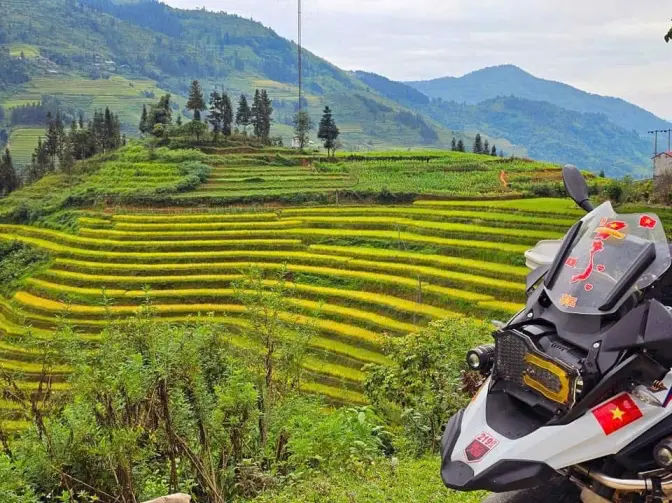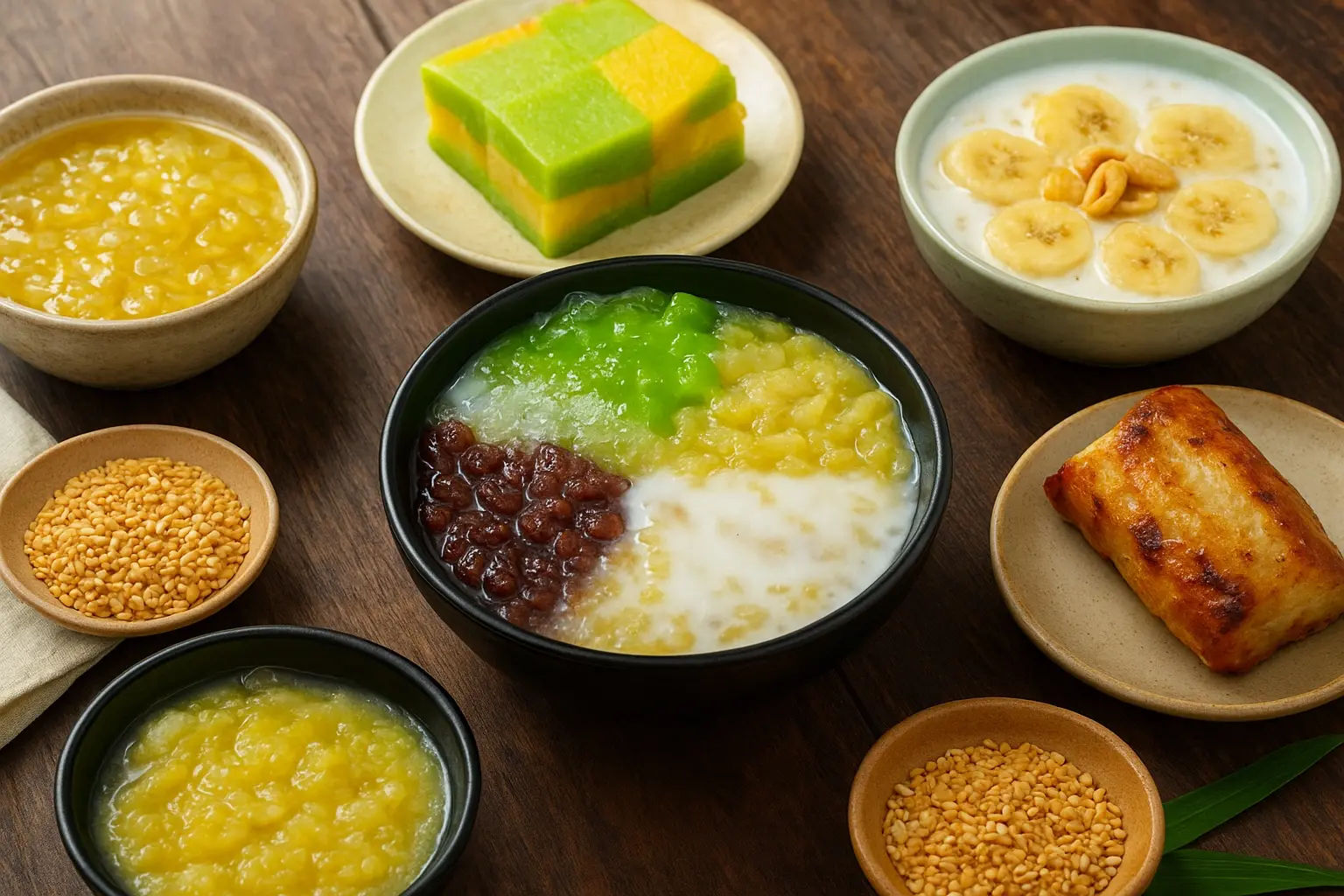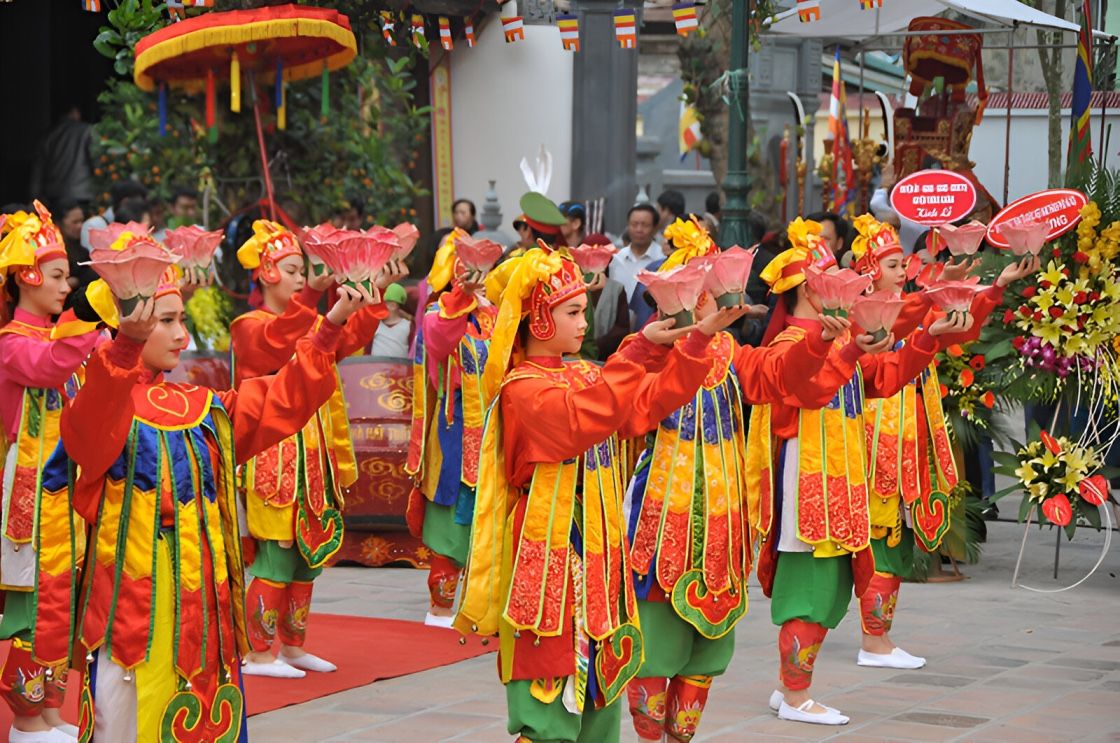
Vietnamese desserts are a delicious mix of local creativity using fresh tropical fruits, coconut, and rice, these sweet treats reflect both traditional flavors and French influence. In this guide by Vietnamese Motorbike Tours, you’ll discover the most popular desserts in Vietnam, from refreshing sweet soups to tasty cakes and pastries — and learn what makes Vietnam’s dessert culture so unique and loved.
What Makes Vietnamese Desserts Unique?
The desserts you order in Vietnam showcase the country’s rich food diversity, combining fresh tropical ingredients with touches of French influence. These sweet treats come in many forms — from creamy to chewy, hot to cold — and are loved for their variety and balance of flavors.
The main types of Vietnamese desserts include:
- Chè – sweet soups or puddings
- Bánh – cakes and pastries
- Xôi – sticky rice dishes
- Fruit-based desserts
- Sweet beverages
Most desserts feature core ingredients such as coconut milk, pandan leaves, glutinous rice, mung beans, tapioca pearls, and tropical fruits like bananas, mangoes, and durian. Together, these ingredients create everything from refreshing iced desserts for hot days to warm, comforting treats perfect for cooler weather.
- Check out must try Vietnamese foods
1. Chè Ba Màu (The colorful dessert)
Chè Ba Màu, or “three-color dessert,” is one of the most colorful and beloved Vietnamese desserts. Known for its layered look and refreshing taste, this sweet treat offers a perfect balance of texture, flavor, and visual appeal.
A typical serving includes three layers:
- Bottom layer: red beans for sweetness and depth
- Middle layer: yellow mung beans or green jelly
- Top layer: bright green pandan jelly for aroma and color
The dessert is finished with a drizzle of sweetened coconut milk and a scoop of crushed ice, making it the perfect choice for cooling off in Vietnam’s tropical heat. Both locals and visitors love Chè Ba Màu not only for its vibrant appearance but also for its smooth, refreshing flavor — a true symbol of Vietnam’s creativity in dessert making.
2. Chè Chuối (Banana Coconut Sweet Soup)
Chè Chuối, or Banana Coconut Sweet Soup, is a warm and comforting Vietnamese dessert that highlights the country’s love for coconut and tropical fruits. The dish blends ripe bananas with creamy coconut milk to create a rich, fragrant soup that’s both soothing and satisfying.
Soft tapioca pearls add a chewy texture, while pandan leaves infuse the dessert with a gentle, aromatic note. To top it off, roasted peanuts provide a crunchy contrast, making every spoonful delightful.
Though simple in its base ingredients, Chè Chuối has many regional variations — some include taro, pumpkin, sweet potato, or green beans for added flavor and texture. Each version showcases Vietnam’s culinary creativity and its deep appreciation for natural sweetness.
3. Chè Bắp (Sweet Corn Pudding)
Chè Bắp, or Sweet Corn Pudding, is a golden, creamy dessert loved for its natural sweetness and satisfying texture. Made from fresh corn kernels—often from the famous Cam Nam corn in Hoi An—this pudding celebrates the simplicity and richness of Vietnam’s local ingredients.
The dessert combines boiled corn with sugar and a touch of cornstarch for thickness, then topped with smooth coconut milk for a velvety finish. The result is a perfect balance of sweetness and creaminess.
Chè Bắp can be enjoyed warm or chilled, making it a refreshing choice for Vietnam’s warm climate and a comforting treat in cooler weather. It’s a local favorite in Hoi An, often served to travelers eager to experience authentic Vietnamese desserts.
4. Chè Trôi Nước (Sticky Rice Balls in Ginger Syrup)
Chè Trôi Nước is a traditional Vietnamese dessert featuring soft, chewy sticky rice balls filled with sweet mung bean paste. These delicate rice balls are served in a fragrant ginger syrup, offering warmth, comfort, and a touch of spice.
The dessert’s chewy texture contrasts beautifully with the silky filling and aromatic broth, making it both satisfying and soothing. Originally influenced by Chinese cuisine, Chè Trôi Nước is especially popular in northern Vietnam, where it’s often enjoyed during cooler months or festive occasions.
Each bowl reflects Vietnam’s tradition of balancing flavors and textures — a hallmark of Vietnamese sweet soups (Chè).
5. Xôi Xoài (Mango Sticky Rice)
Xôi Xoài, or Mango Sticky Rice, may have Thai roots, but it’s become a beloved part of Vietnamese dessert culture. This tropical favorite combines glutinous sticky rice, sweet coconut milk, and ripe mango slices for a refreshing, satisfying treat.
The preparation involves soaking and steaming glutinous rice before mixing it with coconut milk for a creamy, fragrant base. It’s then served with juicy mangoes and topped with sesame seeds for extra aroma and crunch.
Light, fruity, and deeply flavorful, Xôi Xoài captures the tropical essence of Southeast Asia. It’s the perfect summer dessert — cool, chewy, and naturally sweet.
6. Chuối Nếp Nướng (Grilled Banana Sticky Rice)
Chuối Nếp Nướng, or Grilled Banana Sticky Rice, is one of the most famous Vietnamese street desserts — even recognized by CNN Food as one of the world’s best desserts.
This treat features ripe bananas wrapped in sticky rice, then grilled until the outer layer turns crisp and caramelized. The inside remains soft and sweet, while the grilling adds a smoky, irresistible aroma.
Sometimes garnished with peanuts or sesame seeds, Chuối Nếp Nướng offers a beautiful balance of crunch, sweetness, and charred flavor. You can find it at street stalls across Vietnam, where it’s freshly grilled and served with warm coconut sauce — a true taste of Vietnam’s culinary creativity.
7. Bánh Flan (Crème Caramel)
Bánh Flan is Vietnam’s take on the classic French crème caramel, blending European technique with Vietnamese flair. The dessert features a silky custard base made from eggs, milk, and sugar, gently steamed to achieve a soft, melt-in-your-mouth texture.
What sets Bánh Flan apart is its subtle infusion of vanilla or coconut, adding a uniquely Vietnamese aroma. Once inverted, the golden caramel syrup glazes the top, creating a visually stunning and irresistibly sweet treat.
This fusion dessert beautifully reflects Vietnam’s French colonial influence while showcasing local creativity — a perfect example of how traditional and foreign culinary traditions harmoniously coexist in Vietnamese desserts.
8. Bánh Da Lợn (Steamed Layer Cake)
Bánh Da Lợn, also called “pig skin cake,” gets its name from its layered look that resembles pig skin. This colorful Vietnamese dessert is soft, chewy, and full of flavor.
Each layer is steamed separately — typically green from pandan and yellow from mung beans — giving it its signature chewy texture. Made from rice flour, tapioca starch, coconut milk, and mung beans, this cake offers a perfect balance of sweetness and aroma.
Creating Bánh Da Lợn takes patience and skill, but the result is a beautiful, multi-layered treat that represents the artistry of traditional Vietnamese desserts.
9. Bánh Chuối (Banana Cake)
Bánh Chuối, or Vietnamese Banana Cake, celebrates the natural sweetness of ripe bananas blended with rich coconut milk. It’s soft, moist, and comforting — a true local favorite.
This dessert can be baked, steamed, or even fried like a pancake, each giving a slightly different texture. The ingredients are simple: ripe bananas, sugar, flour, and coconut milk.
You can find Bánh Chuối in bakeries, markets, and coffee shops across Vietnam. Its warm banana flavor and rich texture make it one of the most loved Vietnamese sweets.
10. Bánh Đậu Xanh (Mung Bean Cake)
Originating from Hai Duong city, Bánh Đậu Xanh is a classic Vietnamese mung bean cake that melts in your mouth.
It’s made from finely ground mung beans, sugar, a touch of fat, and fragrant pomelo flower oil. The result is a soft, crumbly, golden-yellow cake that pairs perfectly with a cup of green tea.
This traditional dessert is simple yet elegant, a symbol of Vietnam’s long-standing love for mung beans and delicate flavors.
11. Bánh Bò (Honeycomb Cake)
Bánh Bò, or Honeycomb Cake, is named for its airy, sponge-like texture created by yeast fermentation.
Made from rice flour, coconut milk, sugar, and yeast, it’s light, chewy, and naturally sweet. The pandan version adds a beautiful green color and floral aroma, while the coconut version keeps it classic and simple.
Steamed to perfection, this Vietnamese dessert is popular in the Mekong Delta and loved for its subtle sweetness and fun, springy bite.
12. Bánh Tiêu (Hollow Donuts)
Bánh Tiêu, known as Vietnamese Hollow Donuts, are crispy on the outside and soft on the inside.
They use a yeast dough made from wheat flour and sugar, then deep-fry it until golden and puffed up to create the signature hollow center.
You can enjoy these donuts plain or filled with sweet mung bean paste, shredded coconut, or sesame. Often paired with hot soy milk or Vietnamese coffee, Bánh Tiêu is a must-try street food favorite across Vietnam.
13. Bánh Rán (Fried Glutinous Rice Balls)
Bánh Rán, or Fried Glutinous Rice Balls, are golden, sesame-coated treats with a chewy texture and a sweet mung bean filling. The crispy outside contrasts beautifully with the soft, fragrant inside, making it a favorite during festivals and family gatherings.
This classic dessert is not only delicious but also symbolizes happiness and prosperity in Vietnamese culture.
14. Bánh Đúc Lá Dứa (Pandan Rice Cake)
Bánh Đúc Lá Dứa is a soft, chewy rice cake infused with the fragrant aroma of pandan leaves. Made from rice flour, pandan juice, sugar, and coconut cream, it’s steamed until smooth and then cut into bite-sized pieces.
Toppings like roasted peanuts, shredded coconut, or sesame seeds make it even more flavorful. Its natural green color and light sweetness make it a refreshing and beautiful dessert.
15. Kem Bơ (Avocado Ice Cream)
Kem Bơ, or Vietnamese Avocado Ice Cream, is a creamy tropical dessert that perfectly blends smooth avocado with coconut ice cream.
Originating from Da Nang’s Bac My An Market, it features layers of mashed avocado, coconut ice cream, and a drizzle of coconut milk. Topped with dried coconut and peanuts, it’s rich, refreshing, and ideal for hot days.
This colorful dessert perfectly captures Vietnam’s creative use of tropical fruits in its sweets — making Kem Bơ a must-try modern favorite.
16. Kem Xôi (Sticky Rice with Ice Cream)
Kem Xôi, or Sticky Rice with Ice Cream, is a creative Vietnamese dessert that perfectly blends warm and cold textures. It features soft, fragrant sticky rice topped with a scoop of creamy ice cream — often flavored with coconut or durian for a tropical touch.
The contrast between warm sticky rice and cold ice cream creates a unique balance of comfort and refreshment. Popular among locals and tourists alike, Kem Xôi is easy to find at street vendors and dessert shops across Vietnam, especially on hot summer days.
17. Tào Phớ (Tofu Pudding)
Tào Phớ, also known as Vietnamese Tofu Pudding, is a silky, light dessert that melts in your mouth. Made from fresh soy milk, it has a soft, custard-like texture and a mild, delicate flavor.
Traditionally served with sweet jasmine syrup or soy milk, Tào Phớ offers a refreshing and soothing taste. In the past, street vendors would sell it from bamboo baskets, calling out “Anyone craving for it?” — a nostalgic sound for many Vietnamese.
Today, it remains a beloved and healthy dessert option, especially enjoyed chilled during warm afternoons.
18. Rau Câu (The Jelly)
Rau Câu, or Vietnamese Jelly, is a colorful and refreshing dessert made from agar-agar, a natural seaweed-based gelatin. It’s firmer than regular gelatin and holds its shape beautifully, making it perfect for creative designs.
You can flavor this dessert with coconut milk, pandan, coffee, or tropical fruit juices, creating endless variations. Its bright colors and artistic presentation make it a favorite at parties and family gatherings.
Rau Câu is plant-based, so it’s a popular vegetarian-friendly dessert in Vietnam.
19. Bò Bía Ngọt (Sweet Spring Rolls)
Bò Bía Ngọt, or Sweet Vietnamese Spring Rolls, are a fun and nostalgic snack loved by both kids and adults. Inspired by Chinese popiah, these rolls use thin rice-and-wheat crepes filled with grated coconut, black sesame seeds, and crunchy sugar candy.
They’re often topped with roasted peanuts and drizzled with condensed milk for extra sweetness. The mix of soft crepe and crunchy filling creates an irresistible texture. Commonly sold by street vendors near schools, Bò Bía Ngọt captures the sweet, playful side of Vietnamese desserts.
Where to Find the best Vietnamese Desserts
To experience the best of Vietnamese desserts, head to local markets and street vendors. These spots offer freshly made treats at affordable prices, usually between 5,000 to 15,000 VND.
- Chè Ngon 93 (Hanoi) — Famous for colorful chè varieties like Chè Ba Màu and Chè Chuối. Price: 15,000–35,000 VND
- Bến Thành Market (Ho Chi Minh City) — Street stalls serving traditional chuối nếp nướng and bánh flan. Price: 10,000–30,000 VND
- Cô Ba Chè (Da Nang) — Popular for chè bắp and kem bơ, a local favorite. Price: 20,000–40,000 VND
- Chè Liên (Da Nang & Hanoi) — Known nationwide for creamy coconut-based chè and sweet soups. Price: 25,000–45,000 VND
- Nguyen Thi Street Dessert Stalls (Hue) — Offers authentic bánh lọc ngọt and chè hạt sen (lotus seed sweet soup). Price: 10,000–25,000 VND
Traditional Vietnamese Sweets & Desserts Tourists Must Try
When exploring Vietnamese desserts, focus on places that use fresh ingredients, follow traditional recipes, and offer authentic flavors with care in presentation. You can find these sweet treats almost everywhere in Vietnam—from street vendors and local markets to modern cafés and restaurants—making dessert-hopping affordable and exciting.
From colorful Chè Ba Màu (three-color dessert) and creamy Chè Chuối (banana coconut sweet soup) to the chewy layers of Bánh Da Lợn (steamed layer cake) and smoky Chuối Nếp Nướng (grilled banana sticky rice), Vietnam’s dessert culture is wonderfully diverse. Each bite reflects the country’s love for tropical ingredients, creative combinations, and regional influences.
Whether you’re enjoying a chilled treat in Ho Chi Minh City or a warm pudding in Hanoi, discovering these desserts is one of the most rewarding ways to experience Vietnam’s vibrant food culture.
About the author
Hamid is a travel writer and cultural explorer with a passion for uncovering Vietnam’s rich traditions and hidden gems. He shares local insights and authentic experiences to help travelers connect with the heart of Vietnamese traditions.











